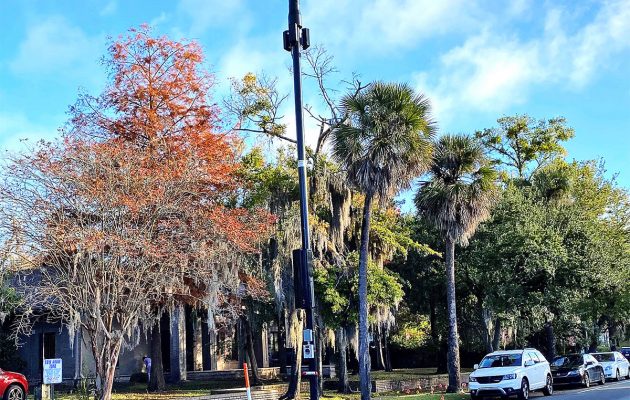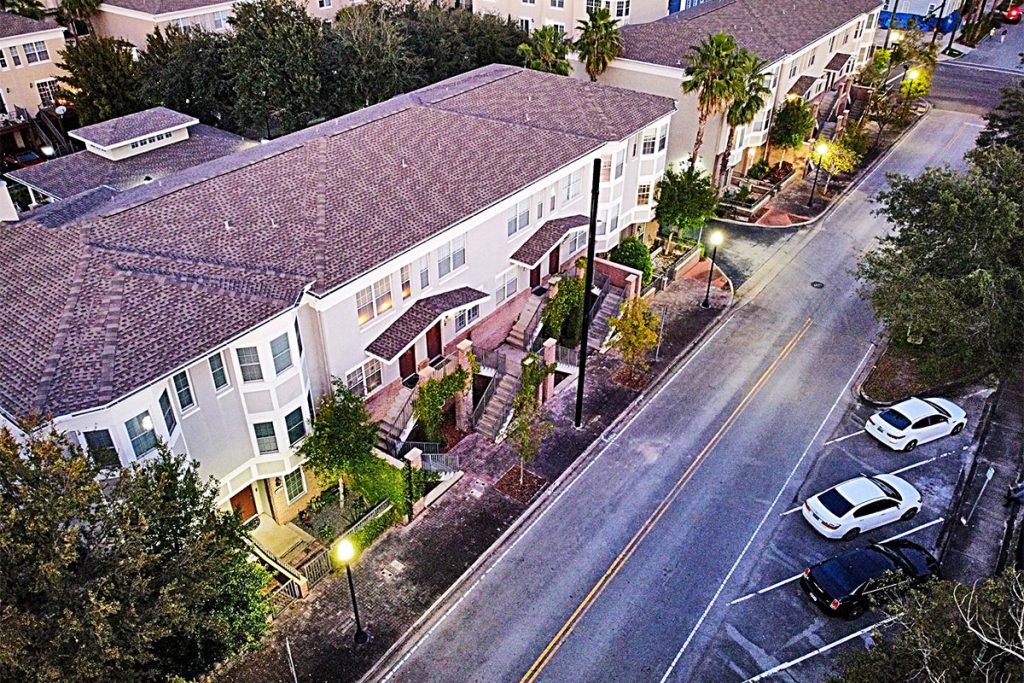5G poles crop up in Riverside
Posted on February 2, 2021 By Marcia Hodgson Neighborhood News, Riverside, Avondale, Ortega, Murray Hill, San Jose, San Marco, St. Nicholas, Top Stories

Tall, black, monolithic poles are starting to crop up in Riverside, and members of Riverside Avondale Preservation (RAP) are not happy about it.
In January, residents driving along Riverside Avenue at Copeland Street noticed a new black utility tower with a large box attached a third of the way up from the ground. Soon many of these towers, which bring 5G capabilities to the neighborhood, will be proliferating on city-owned easements throughout Duval County.
To work effectively, the towers must be spaced close to each other, approximately 200 feet apart, said District 14 City Councilwoman Randy Defoor. DeFoor had been alerted about the black utility tower on Riverside Avenue by RAP. A few days before the tower appeared, RAP Executive Director Warren Jones had attended a City of Jacksonville Historic Preservation Commission meeting to speak about another 5G tower proposed by Verizon to be located at 1113 Margaret Street in 5 Points. The proposed location is directly across from Forbes Street and in front of the entrance of an office building.
“There was a notification that a tower was going to go in on Margaret Street. It was not going to go in front of a historic building, but it was going to go in front of an office building with some very unique architecture,” he said. “The plan is for the very tall, black pole to be placed right in front of the front door, and if you drive down Forbes Street toward Margaret Street that pole is what you would see. It will block the view of the building.”
RAP, Scenic Jacksonville, the owner of the building, and a nearby resident have requested that the placement of the tower in front of the building be moved to another location. After the public hearing, Commissioners debated what legal authority they had to make any changes regarding the placement of the tower and decided to defer a decision to allow a permit until they receive word about the legality of their authority by Jacksonville’s Office of the General Counsel.
RAP is concerned that the appearance of towers in front of historic homes and businesses in its historic district will drive down property values and increase blight, said Jones, who suggests residents and business owners pay attention to blue signs posted at the locations where the poles are to go in. The signs are meant to inform the community that a permit application is being heard by the Historic Preservation Commission. A few other towers have been approved for locations near the Fuller Warren Bridge, Jones said. The city has also permitted two other towers, one slated for the city easement at 721 Post Street and one at 809 College Street, said Marjorie Dennis, a city spokesman.
State mandate
A few years ago, the Federal Communications Commission approved 5G and left it to the states to regulate it through legislation, said DeFoor. In 2017, after dismissing the idea that 5G can adversely affect health, the Florida Legislature passed a law prohibiting local governments from banning or unreasonably restricting the ability of telecommunications companies to install transmission facilities and infrastructure. However, they allowed local governments the ability to require permits for use on public rights-of-way and to regulate “objective design standards, such as size, configuration, color, and shielding of equipment” in ways that still permitted the 5G service to be provided.
Local governments were tasked with granting permits to install the equipment on poles during a specific time period, said State Representative Wyman Duggan, who represents Riverside. “The local government is free to deny the permit application, but then it would go through a permit appeal process,” he said, referring to the Tower Review Committee, and not an appropriate committee of the City Council.
From April to September of 2018, the City Council’s Land Use and Zoning Committee and Transportation, Energy and Utilities Committee held a series of eight joint meetings leading to the passage of Ordinance 2019-770 that regulated the specifics about the placement, location, and design of 5G infrastructure and apparatus. DeFoor had been part of the discussion, which was led by District 11 Councilman Danny Becton.
However, under a mandate from the state, a new Part 4 to Chapter 711 or the Ordinance Code to implement the permitting and objective design standards was adopted via Ordinance 2018-463-E. According to the bill summary, the amended ordinance was drafted by attorneys for Verizon Communications to change numerous provisions of the current code that were problematic for their technology model, which differs from one provider to another based on the manufacturer of their equipment.
According to the bill summary, the amended bill removed language spelling out the city’s right “to minimize the negative aesthetic impact and potential conflicts with other mobility and utility uses caused by a proliferation of new poles and to maximize location context, color, stealth, and concealment requirements in the placement of a Small Wireless Facility within the City’s Rights-of-Way by first requiring co-location on existing structures unless it can be proved to the Director’s satisfaction that co-location is not feasible.”
The original bill was also amended to remove the city’s ability to deny a permit because “a proposed installation fails to comply with ‘applicable objective design standards,’ or because the installation is not proposed to be co-located on an existing structure when the applicant has not demonstrated that such a structure is not available or is insufficient for the placement of the proposed installation.”
In addition, the amended bill deleted several objective design standards, increased the volume of equipment that may be pole mounted from 10 to 28 cubic feet, and deleted the requirement that applications for new poles must be reviewed for the potential to co-locate equipment on existing city, JEA, or privately owned poles or structures. It also removed the requirement that “permits for new poles can only be granted when the Director determines that no existing utility pole is reasonably feasible to collocate the small wireless facilities.”
“I worked hard with Danny Becton and Michael Boylan on the code to try to put as many restrictions as we possibly could into the 5G legislation and the location of their poles. Unfortunately, the state usurped the local control and agreed that 5G could be placed anywhere within the right-of-way easements,” DeFoor said. “Think about that. That means you could have a pole right in front of your house because we all have easements. It’s awful. It’s absolutely awful,” she said.
“I’m of the belief that we really need to go back to the state and tell them this can impact people’s property values, and that it impacts our tax base,” said DeFoor, noting she had been told that JEA was requiring “too much,” for Verizon to rent space on its poles. “If all these poles go up, I would not be at all surprised if a lawsuit was filed by residents because it impacts their property values.”
In fact, a lawsuit was filed with a California appeals court. The U.S. Court of Appeals for the Ninth Circuit largely dismissed a challenge from dozens of state and local governments who tried to push back against the FCC and its orders to restrict their ability to regulate technology for 5G infrastructure. The decision was rendered in August 2020 and may be a precedent that pretty much prevents the City of Jacksonville from being able to enforce any regulations, said DeFoor.
JEA has a Master Wireless Agreement with Verizon, as with all the wireless carriers, allowing collocations on JEA communication towers, hgh voltage electric transmission structures, and JEA electric distribution poles and standalone streetlight poles. A rental does apply allowing JEA and the community an appropriate return on investment for the assets utilized.,” said Simone Garvey-Ewan, media relations coordinator for JEA.
“JEA has been approached by Verizon for collocations on JEA electric distribution poles and standalone streetlight poles for small cell collocation. JEA and Verizon have only looked at 12 sites downtown. Rent for a small cell on an electric distribution pole or standalone streetlight pole is presently $1,432 per year, which is consistent with market analysis of similar utilities and cities. The small cell rent was set per an agreed to contract amendment in 2015 between JEA and Verizon,” she said.
In the Historic Commission meeting, Jones said Verizon’s representative told the group the company had not reached an agreement with JEA to share the utility poles, therefore Verizon must use its own towers. Cellular companies are also not required to share towers with each other, further increasing the number of possible towers in our community.
“We know these towers do not necessarily have to be placed on Verizon’s dedicated poles. They can be placed on existing poles owned by JEA,” Jones said, adding that during the meeting the representative from Verizon said there is a provision in state law that if JEA charges something other than a normal fee the phone company can use its own tower.

Residents in the Riverside Avondale historic district may be among the first to raise an aesthetics alarm on 5G poles, but they are not the only ones. At Large Group 4 Councilman Matt Carlucci said he received a call from Tanner Crews, a resident in Jacksonville’s Cathedral District, who in early December came home from work to discover a towering black pole blocking the line of sight from his window. Carlucci said he is trying to work with the city and Verizon to have the pole removed and placed in a more desirable location. “They aren’t supposed to go in front of windows,” Carlucci said. “I am sending another follow-up to what I sent in December to ask them to take out that pole and place it legally.”
Carlucci’s assistant, Alyson Lee, said she contacted Chief Ellyn Cavin about the pole in the Cathedral District. “Ellyn called me back and said the city had contracted with Verizon to install the poles. She said she did not think Verizon violated the letter of its contract but that she did think the company violated the spirit of the contract. She said she would contact Verizon and see what could be done,” Lee said.
By Marcia Hodgson
Resident Community News




 (1 votes, average: 5.00 out of 5)
(1 votes, average: 5.00 out of 5)5 points, 5G, Riverside Avenue, Riverside Avondale Preservation





